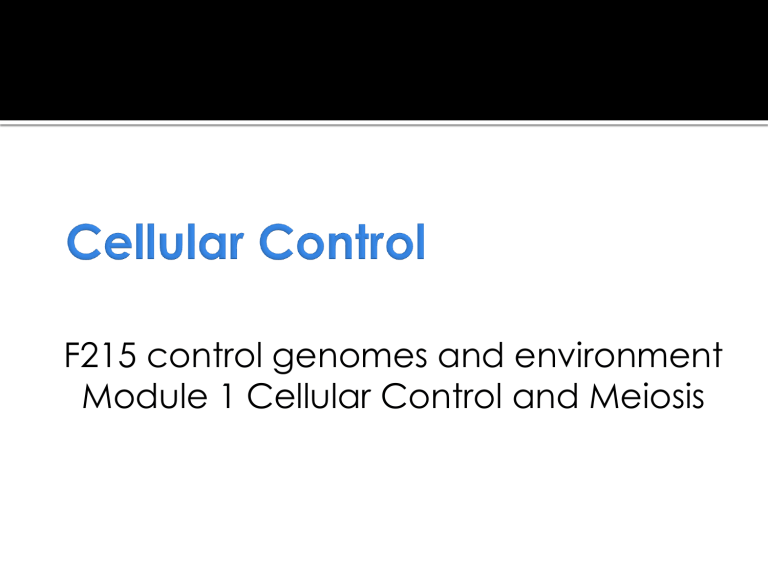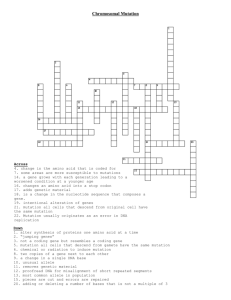File

F215 control genomes and environment
Module 1 Cellular Control and Meiosis
state that genes code for polypeptides, including enzymes; explain the meaning of the term
genetic code; describe, with the aid of diagrams, the way in which a nucleotide sequence codes for the amino acid sequence in a polypeptide;
describe, with the aid of diagrams, how the sequence of nucleotides within a gene is used to construct a polypeptide, including the roles of messenger RNA, transfer RNA and ribosomes;
state that mutations cause changes to the sequence of nucleotides in DNA molecules;
Definitions
Mutation
▪ A change in gene or chromosome structure
Mutant
▪ An individual showing or carrying a mutation
Mutagen
▪ A chemical or physical agents causing a mutation
There are two types of mutation
Gene mutation
▪ Affects a single gene
A chromosome mutation
▪ Affects a single chromosome or set of chromosomes
Occur at random
Are spontaneous
Are rare
Can be increased by chemicals or radiation
This results from a change in base sequence of the DNA of a gene
This means a different protein is coded for
Look at the sequence of bases below:
CCT AGT ATT CGC TGA GGC TAA TG
Now look at the three sequences below
Describe the change you see in each sequence
1.
CCT AGA ATT CGC TGA GGC TAA TG
1.
CCT AGT TTC GCT GAG GCT AAT G
2.
CCT AGT AGT TCG CTG AGG CTA ATG
Use one of the three terms below to describe each sequence
Substitution
Deletion insertion
Substitutions will only alter one codons
This results in only one amino acid in the protein being changed
This is known as a point mutation
Insertions and deletions cause a shift in the whole sequence of bases and all the codons after that point are altered.
This is a frame shift.
explain how mutations can have beneficial, neutral or harmful effects on the way a protein functions
Give suggestions for each of the three effects of mutations below:
Beneficial
Neutral
Harmful
These are mutation which offer a selective advantage to an individual.
Well-adapted organisms can outcompete those in the population without the advantageous characteristic
This is the driving force behind natural selection
If the mutation occurs in the noncoding part of DNA
Silent mutation
Base triplet is changed but has no effect on the amino acid coded for.
70% of cystic fibrosis sufferers, the mutation is a deletion of a triplet of base pairs
Protooncogenes can be changed into
oncogenes by a point mutation, which promote uncontrolled cell division
Huntington disease is caused by a stutter – this is repeating sections of
CAG sequences,
Haemoglobin
Globular protein
▪ Two α polypeptide chains
▪ Two β polypeptide chains
A mutation in the gene coding for the β chain causes sickle cell anaemia
When the four polypeptide chains curl up they form a specific 3-D shape
Some amino acids have hydrophobic side chains e.g. valine
Some amino acids have hydrophillic side chains e.g. glutamate
If the O
2 level in blood falls, valines form bonds with themselves that stick haemoglobin molecules together, producing long chains of stuck-together haemoglobin molecules, the RBC is pulled out of its usual biconcave shape.
If a mutation changes a characteristic, there can be an advantage or a disadvantage to having this new character.
the environment plays a role in determining the likelihood of this characteristic being maintained through natural selection.
Background:
Melanin is a skin pigment that protects cells from the harmful effects of UV radiation.
Vitamin D is synthesised when skin is exposed to sunlight.
Dark skin protects from harmful UV rays.
Sunlight is intense enough to synthesis vit.D.
Light skin does not shield against harmful
UV- causes skin cancer.
Vitamin D can be synthesised
Dark skin not needed to protect against UV.
Melanin prevents sunlight synthesising vitamin D.
Sunlight less intenselowered intensity of UV
(no skin cancer)
Vitamin D can be synthesised
The Inuit people still retain some skin pigments, but do not live in an environment with high levels of
UV/sunlight.
Is melanin a disadvantage?
Diet is high in Vitamin D, so no need to reduce melanin levels in order to synthesise vitamin D.
state that cyclic AMP activates proteins by altering their threedimensional structure;
explain genetic control of protein production in a prokaryote using the
lac operon
E. coli is capable of synthesising a variety of different enzymes, depending on their environment.
E. coli only produce enzymes needed to metabolise lactose when lactose is present in the substrate
ß-galactosidase:
▪ catalyses hydrolysis of lactose.
Lactose permease:
▪ transports lactose into the cell.
The operon consists of several genes
Regulatory gene for lac operon
Control sites Structural genes
P: Promoter region. RNA polymerase binds here to start transcription of Z & Y.
O: Operator region. Switches Z & Y on and off.
Z: Codes for ß-galactosidase.
Y: Codes for lactose permease.
What Happens Without Lactose?
mRNA ribosome repressor protein
Regulator gene is expressed and produces REPRESSOR PROTEIN.
One binding site on Repressor protein binds to operator region, covering promoter region where RNA polymerase would attach.
RNA polymerase cannot bind to promoter region and neither gene Z or Y is expressed.
What Happens With Lactose?
ß-galactosidase Lactose permease lactose
Lactose binds to other binding site on repressor protein, changing the shape.
Repressor protein cannot bind to operator region
RNA polymerase binds to promoter region and genes Z & Y are expressed.
explain that the genes that control development of body plans are similar in plants, animals and fungi, with reference to homeobox sequences
(HSW1);
Homeobox genes determine how an organism’s body develops as it grows from a zygote into a complete organism.
They determine the organism’s body plan
These sequences are highly conserved, which implies that their activity is fundamental to the development of an organism
Homeobox genes have been discovered in animals, plants and fungi
These are the sequences of 60 amino acids in the proteins coded for by the homeobox genes
Antp in a fruit fly and
HoxB7 in a mouse.
All animals have homologous homeobox genes – they are recognisably similar
Drosophila melanogaster a.k.a. fruit fly
Body is divided into
Head
Thorax abdomen
Development is mediated by homeobox genes
Maternal effect genes determine the embryo’s polarity e.g. anterior (head) & posterior (tail / abdomen)
Segmentation genes determine polarity of each segment
Homeotic selector genes identify and direct the development of each segment
▪ Two groups exist, that control development of (i) head + thorax segments and (ii) thorax + abdomen segments.
The Thorax of the fruit fly is split into 3 segments
T1 – a pair of legs
T2 – a pair of legs and a pair of wings
T3 – a pair of legs and a pair of halteres
A homeobox gene called
Ubx stops the formation of wings in T3.
A mutation in both copies of
Ubx
, wings grow in T3 instead of halteres.
Ubx
Mutant
Ubx
If the homeobox gene
Antp is usually turned on in the thorax, where it causes legs to develop.
In mutant flies where
Antp is switched on in the head, legs grow instead of antennae
Homeobox genes code for the production of transcription factors
These proteins can bind to a particular region of DNA and cause it to be transcribed
A single homeobox gene can switch on a whole collection of other genes, regulating gene expression
• Hox clusters are aggregations of homeobox genes and are found in all animals.
• Examples
• Nematodes have one Hox cluster
• Fruit flies have 2 Hox clusters
• Vertebrates have 4 Hox clusters
Effect of thalidomide in embryo development
Homeobox genes HoxA11 and HoxD11 switch on genes that cause forelimb development.
The drug thalidomide affected the behaviour of these homeobox genes at a critical stage in embryonic development.
Retinoic acid and birth defects
Retinoic acid
▪ is a derivative of vitamin A
▪ activates homeobox genes in vertebrates
▪ Is a morphogen (substance governing pattern of tissue development).
If a pregnant woman takes too much
Vitamin A, it can interfere with the expression of these genes causing birth defects in the central nervous system and axial skeleton
http://www.dnaftb.org/dnaftb/37/con cept/index.html
If you have time, sit and watch this animation, as well as investigating other aspects of this web site.
outline how apoptosis (programmed cell death) can act as a mechanism to change body plans
Apoptosis is programmed cell death in development
Series of biochemical events leading to an orderly and tidy cell death
Hayflick Constant
Cells undergo about 50 mitotic divisions before apoptosis
Necrosis
Untidy and damaging cell death occurring after trauma
Enzymes breakdown cell cytoplasm
Cytoplasm becomes dense
Organelles are tightly packed
Cell surface membrane changes and blebs form
Chromatin condenses, nuclear envelope breaks
Cell breaks into vesicles phagocytosis
Apoptosis is controlled by cell signalling
Cytokines from the immune system
Hormones and growth factors
Nitric oxide
▪ Makes inner mitochondrial membrane more permeable to hydrogen ions
The rate of cells dying should balance the rate of cells produced by mitosis
Not enough apoptosis leads to the formation of tumours
Too much leads to cell loss and degeneration
Cell signalling plays a role in maintaining the correct balance
The formation of the digits (fingers and toes) occurs due to apoptosis during the development of the embryo.
As tadpoles grow they develop legs, change their body shape and lose their tails
The tail is lost by apoptosis







